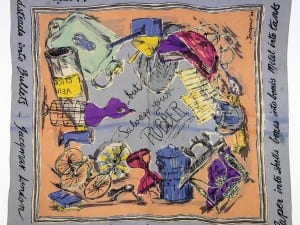In 1999, Jonas Mekas, the Lithuanian-born American film-maker, artist and poet, wrote, “I am a film-maker and a poet / I am a huge image projector / I make up, in my mind – or is it in my heart? – images, all the time… Some images I pick up from the ‘real’ world / and I film them; some others come from much deeper / and I do not have any control of them.” How was it possible that Mekas identified and defined his work so thoroughly yet so plainly? How was it possible that despite all the cruelty he witnessed in this world he succeeded in becoming and remaining a productive, self-assured and constructive artist?
On December 24, Jonas Mekas was 90 years of age. Ninety is a number easily said. However, imagine 90 years of seeing, feeling, sensing, thinking, surviving, striving, working and creating. With this image in mind, 90 becomes a world within itself. Excesses of patience, virility, perseverance, understanding, continuity and a gargantuan memory are needed to achieve all that he has.
The exhibition titled Jonas Mekas currently on display at the Serpentine Gallery in Kensington Gardens, London brings forth a massive array of Mekas’ work. Film stills, photographs, posters, digital prints, video installations… Poems that roll off the tongue, aged published books of poetry, sincere and explanatory captions explaining the works. Liveliness emanates from the exhibition and Mekas’ voice seeps deeper and deeper into the skin. Hundreds of minutes of film unravels in white, black, red, green, blue, yellow. The sun shines, the rain trickles, snow covers the ground and hundreds of film cans are on the shelves. The world is in constant motion in Mekas’ films. Somewhere amidst all this, time slips away. Outside the Serpentine Gallery the sun begins to hide as the evening sky approaches. The works, A Few Things I Want to Share with You, My Paris Friends (2009), 356 Day Project (2007), The First 40 (2006) constitute a tiny fraction of Mekas’ life-long work. In all its unity, Mekas’ work is rich yet subdued, lively but lonely, colourful but serious.
One of the writings included in the film stills (namely, To New York with Love, 2007) reads, “YOU LOOK AT THE SUN. THEN YOU RETURN HOME AND YOU CAN’T WORK, YOU’RE IMPREGNATE WITH ALL THAT LIGHT” and in the middle we see Mekas in his work space, beaming Cerulean blue, looking out the window with his hands placed on his hips and his back to the camera. That is exactly how the artist’s work may make the visitors feel. You look at his work. Then you return home and you can’t work, you’re impregnate with all that light. All that light, love, colour and shadow…
Spending months in the Elmshorn labour camp, living in displaced person camps in Wiesbaden and Kassel, being arrested for his brave and genuine work, surviving wars, loss and the depravity of the powers that be, Mekas emerges before us as a man of strength, light and inner beauty as he opens his arms and says, “Come all my friends, installations, my new movie, outtakes from the life of a happy man!” If gruesome times are never experienced, how can a man know happiness? Of his 90 years of life, over 60 years have been dedicated to film, art and poetry. One might even say that the day Mekas borrowed the money to buy his first Bolex camera was the day that gave him the key to perseverance, leading to success and happiness in life. Could it take the best part of a century to embrace happiness in the face of so many years of strife? Ask Jonas Mekas, the godfather of American avant-garde cinema.
Jonas Mekas, until 27 January, Serpentine Gallery, Kensington Gardens, London W2 3XA.
Hande Eagle
Credits
1. Jonas Mekas, Photograph: Liz Wendelbo © Jonas Mekas
2. Jonas Mekas, This Side of Paradise 1999, Kennedy family holiday in Montauk, New York, 1972 16mm film frame © 2012 Jonas Mekas
3. LAVENDER PIECE 2012, 16mm film transferred to video, various dates, Each film 5-15min long, Bolex cameras owned by Mekas, Installation view, Jonas Mekas, Serpentine Gallery, London (5 December 2012 – 27 January 2013)© 2012 Jerry Hardman-Jones





